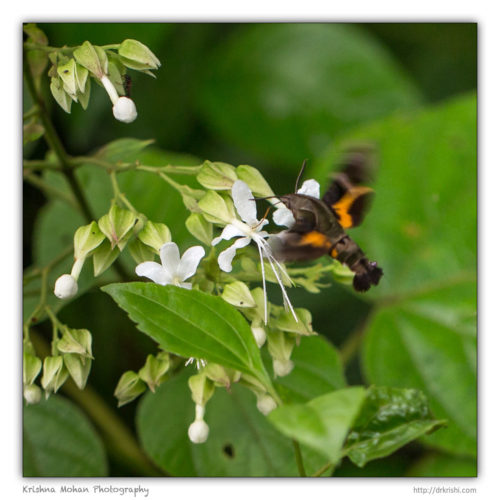
I encountered this dainty little Hummingbird hawk-moth, on a morning walk while attending an amphibian workshop conducted by the inimitable Dr. K. V. Gururaja, purveyor of all things amphibian, at Karkala.
Since this was an impromptu ramble, I was armed only with a Canon EF 100mm f/2.8L Macro IS USM lens fitted on my trusty Canon EOS 5D Mark III. Owing to the low light conditions afforded by the early hours of dawn, I opted for a shutter speed of 1/800th. of a second at f/2.8 and ISO 500, to capture the moth’s rapid movements. The images presented below, for your viewing pleasure, have been cropped by about 25% from their original state of capture, since such fast moving organisms are often difficult to focus one’s equipment on and I only just managed to work around the fact by utilizing a center focus point, further assisted with 4 other adjacent points, in order to burst capture.

Hummingbird hawk-moths, (Macroglossum species) as their name suggests, belong to the immensely popular Lepidoptera family Sphingidae. Their long proboscis, when extended for feeding and the ability to hover, accompanied by a distinctly audible ‘humming’ noise when in flight, owing to rapid wing movement, makes them appear remarkably like miniature hummingbirds, whilst feeding. Another peculiarity of these moths is the fact that they are sun worshippers, much like their dainty cousins, the butterflies and unlike the vast majority of their nocturnal brethern, the moths, preferring to be on the wing during daylight hours, especially in bright sunlight. They’re also active during the wee hours of dawn and dusk and even during rains, which is unusual, even for those handful of moths with diurnal inclinations. The visual abilities of these moths have been much studied, and they’ve been shown to have a relatively good ability to learn and comprehend colors.

They are widely distributed throughout the Northern Old World, from Portugal to Japan, but are resident only in the warmer climes (Southern Europe, North Africa, and points east). They are strong fliers, dispersing widely and are virtually encountered everywhere in the hemisphere during summer, though they rarely survive the harsh winter of the northern latitudes (e.g. North of the Alps in Europe, North of the Caucasus in Russia). Additionally, they have also been spotted in Newfoundland, Canada.

Hummingbird hawk-moths can often be found in a wide variety of habitats, ranging from urban gardens, public parks, meadows, scrub and brush jungles to the edges of woodlands, where their food plants can sometimes be found growing. The caterpillars have been observed feeding on Strychnos angustiflora in Hong Kong and on Strychnos nux-vomica,Saprosoma indicum and Spermadictyon suaveolans in India. Adult moths are particularly fond of nectar-rich flowers with a long and narrow calyx, which allow them to fully utilize their long proboscis, thereby avoiding competition with other nectar feeders. They are also know to trap-line, that is, return to the same flower beds around the same time, each day.


Hello. I just discovered this beauty in my urban terrace garden. Your blog has my curiosity satiated ? including how to capture the moth. Thank you
Thank you, It is my pleasure 🙂